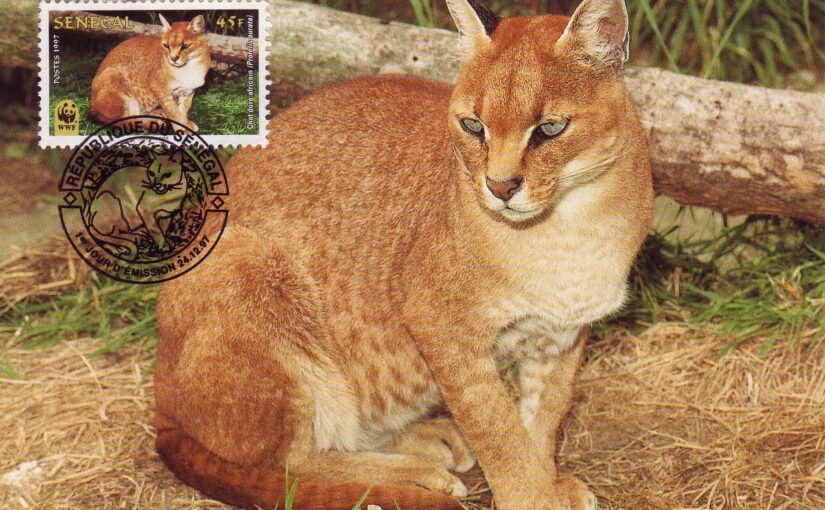In the deep, shadowy forests of Africa lives a cat so beautiful and secretive that many people have never even heard of it. The African golden cat, Profelis aurata, is a rare and mysterious predator, perfectly adapted to the dense tropical landscapes it inhabits. It is often called the hidden jewel of Africa’s rainforests, and anyone who has been lucky enough to glimpse one would agree.
The first impression of this cat is one of elegance. Its fur is remarkable for its wide range of colors. Some individuals glow copper red, others shine with golden gray tones, while still others appear in shades of dark brown or soft gray. The cheeks, belly, and inner legs are usually white, contrasting with the rest of the coat. On top of this base, the pattern varies widely. Some golden cats are heavily spotted, others faintly flecked, and some appear almost plain. Each individual wears its own unique design, as if the forest had painted it for camouflage.
What makes the golden cat even more intriguing is its invisibility. It prefers the tropical forests of western, central, and eastern Africa and has been recorded even in high-altitude cloud forests, as far as 3600 meters above sea level in Uganda. Yet despite such a wide range, it is almost never seen. By day it conceals itself, often resting on tree branches where cover is thick. By night or during the twilight hours, it emerges silently to hunt.
Its prey reflects the world it inhabits. The golden cat targets small to medium sized animals, including birds, rodents, small antelopes, and sometimes livestock such as chickens. This appetite occasionally brings it near human villages. However, even when it lives close to people it remains a ghost, vanishing into the forest the moment it senses disturbance.
Local traditions in Africa add layers of myth and mystery around this elusive predator. In Cameroon, naturalists were once shown royal garments made from golden cat pelts, but local chiefs never disclosed the areas where the animals were hunted. Among some pygmy groups, the cat’s tail is revered as a charm believed to bring success in elephant hunting. These cultural associations illustrate how long the golden cat has been known in local folklore, even as scientists continue to struggle for basic knowledge of its life.
Physically, the African golden cat is more than twice the size of a domestic cat. Its body is compact and muscular, its long legs give it impressive agility, and its paws are large and strong. The head is small, with rounded ears, and the tail is of medium length. All of these features combine into a predator built for silent moves and sudden bursts of strength. Males weigh between 11 and 14 kilograms, while the single recorded weight of a female was noticeably lighter at just over 6 kilograms. Its size, strength, and ability to vanish make it one of the most formidable hunters of the African forest understorey.
Measurements suggest that the body length can vary between 61 and 100 centimeters, with tails ranging from 16 to 46 centimeters. At the shoulder they stand between 38 and 55 centimeters tall, which makes them sturdy and powerful for their size. They are most closely related to the caracal and the serval, two other distinctive African cats, but their appearance and behavior set them apart. The golden cat is uniquely tied to the forests and nowhere else.
Despite centuries of coexistence with people, very little is known about the golden cat’s behavior. Researchers cannot yet describe its family life in the wild. It remains uncertain how long kittens stay with their mother or how the cats structure territory. What we do know comes mainly from camera traps, rare sightings, and indirect observations such as footprints or prey remains. The lack of detailed knowledge adds to its enigmatic reputation. Among the thirty-seven species of wild cats, it is considered one of the most poorly studied.
What is clear is that the African golden cat is a creature of twilight. It is most active at dawn and dusk, gliding quietly through undergrowth where even the sharpest eyes may miss it. Its hunting is swift and decisive, defined by precision pounces and a strength disproportionate to its size. And when the sun lights the forest canopy, this cat disappears again into stillness, a shadow perched in trees or hidden in dense vegetation.
For many, the African golden cat is known mainly through local legends, museum skins, or photographs captured on rare expeditions. Yet its importance for the ecosystem is great. As a mid-sized predator it helps regulate prey populations and maintain the balance of the rainforest. Its presence indicates the health of the environment, as such cats can only thrive where forests are thick and prey is abundant.
More than an animal, the golden cat is in many ways a symbol of the African forest itself: beautiful yet concealed, powerful yet shy, fragile in the face of encroaching dangers, and still holding secrets that modern science has yet to uncover. In the quiet depths of the rainforest, as cicadas hum and shafts of light cut through the canopy, the golden cat slips through the foliage unseen. It is the hidden heartbeat of an ecosystem, reminded to us only by soft paw prints in mud or a fleeting shadow in the dusk.
To know that such an animal still roams Africa’s forests is to be reminded of the untamed beauty that survives alongside us. Protecting it is not only about saving a little-known species. It is also about preserving the forest, its culture, and its balance. The African golden cat may be poorly understood, but it is undoubtedly one of the most enchanting and important guardians of the continent’s wild places.
If you find joy in these tales of twitching whiskers and gleaming eyes, consider helping keep Whiskerito.com alive and purring. Your donation supports thoughtful research, engaging content, and the warm, wonder-filled community that makes this space what it is.
